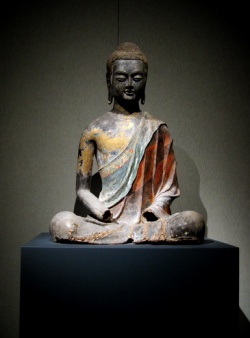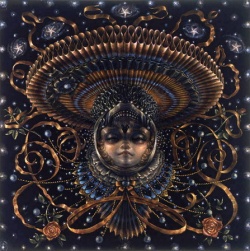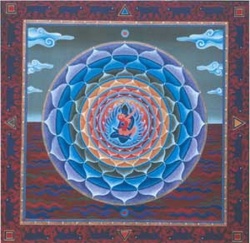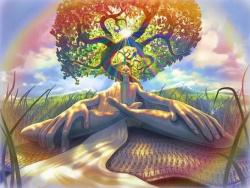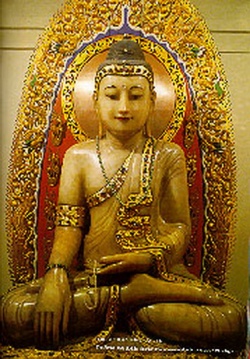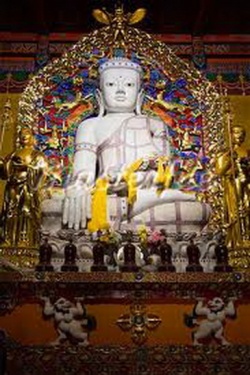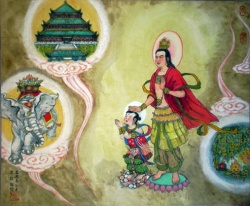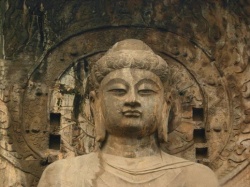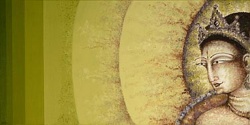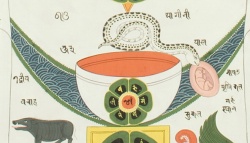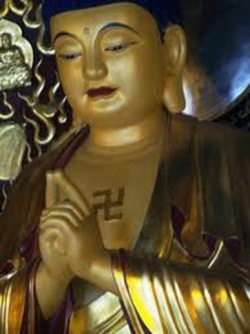Loka: The Buddha’s Formulation of the Universe Richard R. Crutcher
Loka: The Buddha’s Formulation of the Universe Richard R. Crutcher a paper delivered to the conference: Insights from an Ancient Tradition: Spirituality and Science in the Light of Vipassana Meditation September 3-4, 2000 Several months ago, when I was initially invited to address this gathering, I hesitated at first when I heard that the theme of the conference was to be “science and Vipassana, the teaching of the Buddha.” I hesitated because I am not a scientist or a doctor, like the other speakers, and as I suppose many of you must be. I have no formal scientific training—my university studies focused on religion—and so I doubted that I would have much to add to the discussions here.
As I reflected on the place and the role of science in our world today, however, I changed my mind and decided that I might enjoy the opportunity to look at some of the correspondences and some of the differences between the Dhamma—which after all means “law of nature”—and that accepted body of “observed reality” that is slowly being revealed by the scientific method. Science has been a fact of life—a human enterprise—for perhaps 400 years if we look back to the great Copernican-Galilean revolution during the Renaissance in Europe.
I see that “event” as being the point at which objective observation of the world and rational thought began to challenge and eventually overtake the mythico-religious description of the world that had prevailed in Europe up until then. Or perhaps we should push our timeline further back to the earliest foundations of scientific thought found in the logical speculations of Thales and Democritus, the mathematical experimentation of Pythagoras and the Socratic method of inquiry of the sixth and fifth centuries BC, in ancient Greece. Even though these early Greek thinkers were not practicing what we would recognize today as a fully evolved scientific method of inquiry, the roots of empirical observation were present in their work and the ancient Greek philosophers are generally accepted today as the forerunners of what became the scientific method.
It is also instructive, in light of our proposed discussion here today, to recognize that these thinkers, living on the shores of the Aegean Sea, to whom we look as the founders of Western thought and culture, were contemporary with Gotama the Buddha, who resided a bit farther east in the Ganges basin of India. So we can say that science has been evolving as a factor in human culture for perhaps twentyfive centuries and has been increasingly ascendant as a force in our lives for the past four to five centuries. But religion has existed and regulated the life of mankind seemingly from the earliest dawn of the human species—at least for tens of thousands of years, as archeology continues to reveal.
The roles of religion, philosophy and science are not entirely distinct, though they have been defined as separate disciplines, and though they may occupy different buildings on our campuses today. One of the primary purposes of religion in human culture is that it provides us with a creation myth. It explains the observable phenomena of the world in which we find ourselves by explaining how the world came to be; how and why it is maintained as it is; and by predicting what its ultimate end will be. In the course of this mythico-religious description of the world, humankind’s place is defined and a moral framework is constructed that gives a rationale for moderating our baser behaviors in light of our relationship to the whole of the creation.
It is obvious to me that in the last few centuries the scientific method has proved so undeniably successful at describing the phenomena of the world around us that it is, in fact, the provider of our current creation myth. Moreover, the scientific view of the world has effectively overwhelmed—or perhaps undermined is a better word—all other creation myths on the planet.
This is not to say that the various religious worldviews of earlier times have easily and willingly faded away; far from it! Discoveries of natural laws in astronomy and physics have progressively removed the planet Earth from the center of the solar system, relocated the solar system to the 1 remote edge of an ordinary galaxy among millions of other solar systems and then discovered millions of such galaxies all receding from each other in an expanding universe of previously unimaginable dimensions and age. As a result, fundamentalist movements have sprung up in most religions to try to defend the traditional teachings of scripture. We are all familiar with the sad history of religious upheavals, excommunications, inquisitions, and fatwahs that have resulted from the clash between traditional religious beliefs and the findings of various disciplines of science.
The theory of evolution has replaced a more personal, theocentric myth of human creation; microbiology has unraveled the secrets of DNA and found the means of manipulating the very foundations of life; and the medical sciences continue to probe the neurological and chemical basis of mental activity. As these and other scientific explanations have gained credibility, the old expositions of morality, which were hung on the framework of the traditional creation myths, have shown increasing signs of stress. If the old myths no longer provide an adequate rationale for ethical behavior, then what does? Does the scientific worldview provide us with an alternative? This is a question I want to return to before we part today.
Amid all of this ongoing tension between the scientific worldview and traditional religious systems, it is interesting to note that there has not been a development of fundamentalist Buddhism in any part of the world. Nor has there been, among Buddhists, a history of suppression of modern scientific thought in order to protect the validity of scriptural doctrine. On the contrary, among the followers of the Buddha, there has been a general embrace of the findings of all branches of science. And conversely, there has been an acknowledgement, if not an active embrace, among some well-known scientists of the Buddha’s teaching.1 Let’s explore why that is so. There are some intriguing parallels between the Buddha’s view of the world and the scientific worldview, but they are not completely analogous. First and foremost we must recognize that the purpose of a scientist and the purpose of a Buddha are entirely different. Science, as a human enterprise, sets about to examine the physical universe in an attempt to discover the laws by which it operates.
It is an ever-evolving body of theory, each succeeding model lasting only until it is disproved. The great historian of science, Thomas Khun, who gave us the term “paradigm” to describe the generally accepted model in any scientific discipline at any given time, also pointed out that the concept of “scientific progress” is inherent in any activity that we normally consider to be science. A scientist can never claim to have discovered the truth—only that the paradigm on which he or she has based her assumptions seems to explain the observed facts as far as is known at present.
Every scientist knows that each unsolved puzzle remaining in his or her field has the potential to overturn the model, leading to a more refined model, and a whole new set of puzzles. Nonetheless, despite this inherent uncertainty at the core of science, the ongoing quest of science as a whole, if not of the individual scientist, is to uncover the truth of the universe. The holy grail of science remains the unified field theory that will explain all forces and all matter in a single elegant formula. A Buddha, on the other hand, sets out with a different purpose.
He arrives at a stage of knowledge of the universe that is vast, leaving nothing left to explore, but has as its goal the reform of the forces of the universe rather than simply the comprehensive knowledge of them. The Buddha’s extensive teaching has been preserved in the Pāli literature (also known as the Tipiṭaka). In one of his discourses from the Tipiṭaka the Buddha succinctly describes the extent of his knowledge: Bhikkhus, the world has been discovered by the Tathāgata; the Tathāgata is dissociated from the world. The origin of the world has been discovered by the Tathāgata; the Tathāgata has abandoned the origin of the world. The cessation of the world has been discovered by the Tathāgata; the Tathāgata has realized the cessation of the world.
The 2 way leading to the cessation of the world has been discovered by the Tathāgata; the Tathāgata has established the way leading to the cessation of the world. In the world with its devas, its māras, its brahmas, its ascetics and brahmins, its devas and humans, whatever, bhikkhus, can be seen, heard, sensed, cognized, or reached, sought out and encompassed by the mind has been discovered by the Tathāgata…2 This bold statement about the Buddha’s knowledge of the world echoes the formula he uses when he declares the Four Noble Truths, the most fundamental statement of his teaching for the world, in which he sets out in the most basic terms the purpose of his quest: to find an end to dukkha, or suffering. Here he substitutes the word “loka” (or “world”) for the more familiar word “dukkha.” He then goes on to claim full and complete familiarity with the world, its origin, its cessation and the means to its cessation.
The Buddha spoke about the world often and in diverse situations. In fact, in the Buddhavandanā 3 (the “Homage to the Buddha,” which is traditionally chanted in the morning at meditation courses and in monasteries and temples everywhere) one of the several epithets of the Buddha that is mentioned is that he is “lokavidu”—that is, that he is “one who knows the universe.” And yet, having declared that he possesses such complete knowledge of the world, he also states, in another place, that he does not reveal all he knows:
The Blessed One was once living at Kosambī in a forest of Siṃsapa trees. He picked up a few leaves in his hand and he asked the bhikkhus: “What do you think, bhikkhus, which is greater, the few leaves that I hold in my hand or those on the trees in this forest?” “The leaves that the Blessed One has in his hand are few, Bhante; those in the forest are far more numerous.” “So too, bhikkhus, the things that I have known by direct knowledge are far more; the things that I have told you are only a few. Why haven’t I told them? Because they bring no benefit, no advancement in the holy life, because they do not lead to dispassion, to fading, to ceasing, to stilling, to direct knowledge, to enlightenment, to Nibbāna.
And what have I told you? ‘This is suffering, this is the origin of suffering, this is the cessation of suffering, this is the way leading to the cessation of suffering.’” 4 He makes it abundantly clear that his interest is in bringing benefit to the world, in “advancement in the holy life,” rather than in merely exploring the mechanics of the universe. Contained in these statements are several important elements of the Buddha’s worldview. In attempting to compare the Buddha’s knowledge of the universe and the collective knowledge of modern science, let us notice first of all that the Buddha uses no instruments to investigate the world. He performs only internal, experiential experiments and has discovered, “whatever can be seen, heard, sensed, cognized, or reached, sought out and encompassed by the mind.” His method, as we see, is radically empirical; it is discovery by direct experience and direct knowledge. We must also note here that the world he describes is multi-layered, containing devas, brahmas, māras—many other beings besides humans and animals.
The worldview of the Buddha and his followers down through the centuries includes thirty-one planes of existence, also referred to as lokas. We will not spend too much time on all the features of this complex cosmology, but the outline of it is important because, as we shall see, the multi-layered aspect of the universe is directly related to the Buddha’s formulation of evolution. As individual beings evolve and move among the various lokas, so the universe organizes itself into these planes of existence.
The moral 3 and psychological laws of nature interweave with this system of realms in an incontrovertible fashion that becomes the very mechanics of the universal creation. As described by the Buddha, this multi-layered cosmos is divided into three broad groups: the realm of sense-desire, the fine-material realm and the immaterial realm. The sense-desire realm (or the kāma-loka—so-called because sensual desire prevails there) is made up of eleven planes. Ranging in ascending order, there are the four undesirable destinations made up of (1) various hell realms; (2) the titans (asurā) who are involved in continual conflict and combat; (3) the hungry ghosts (peta) who are afflicted by constant unfulfilled craving; and (4) the animal plane.
The desirable destinations within the kāma-loka include the human plane and six heavenly planes of devas. Above, or higher than the kāma-loka is the fine-material realm (the rūpa-loka—so-called because the grosser forms of matter are no longer present in these planes). The rūpa-loka consists of sixteen planes inhabited by brahmas. The worlds of these beings correspond to the attainments of the first four jhānas, or levels of absorption samādhi. The final four planes comprise the immaterial realm, the arūpa-loka. These are planes without physical form at all, in which the beings, known as arūpa-brahmas, have only mental activity and dwell in the deep peace of the fifth to the eighth jhānas.
Beings are born into one or another of these realms based on their accumulated actions from the past, or their kamma (better known in the West by its Sanskrit equivalent: karma). Kamma means, literally, “action” and the Buddha defines it as “volition” (cetanā).6 The universe described here is one based on complete conditionality of action—laws of cause and effect that cannot be transgressed. In a succinct definition of the conditional nature of all phenomena the Buddha said, “That comes to be when there is this; that arises with the arising of this.
That does not come to be when there is not this; that ceases with the cessation of this.”7 In this statement of the abstract principle of dependent origination the Buddha approaches the purity of definition of Newton’s third law of motion: for every action there is an equal and opposite reaction. The Buddha would say, rather, for every action there is an equal and appropriate result. In his formulation of this highly structured and complex cosmology the Buddha goes beyond the universe that is observable by the five physical senses.
The classical scientific worldview of the eighteenth and nineteenth centuries was limited to the “observable universe” but we have seen developments in scientific theory in the latter half of the twentieth century that so far clearly transcend anything that can be tested or observed. In the latest attempts to unify the theory of General Relativity and Quantum theory, scientists and mathematicians have proposed a new paradigm called String theory.
As they are working out the implications of this new theory they find that it is necessary to assume that at least ten dimensions must exist in the universe. These include the three dimensions of conventional physical space that we all inhabit; time, as a fourth dimension; and at least six other dimensions that are not visible. Science, as we have seen, is always refining its understanding of the universe. Perhaps as time goes on and String theory (or whatever replaces it) is refined we will find that more unseen dimensions are discovered.
In the Pāli literature each of these realms, or lokas, whether visible or invisible, is understood to be an objective plane of existence which is a counterpart of some action, whether physical or mental, of the beings who inhabit them. These planes are taken to be destinations for successive births of beings. Each birth is based on the actions, or kamma, accumulated in previous lives. In some planes these lives are said to be extremely long lasting. There is a noteworthy feature of the Buddha’s characterization of this cosmology: namely that, while he used aspects of the pre- Buddhist, Vedic cosmology commonly accepted in his time, he did not adopt it wholesale as he set about explaining the nature of the world. He altered it to suit the reality he had experienced.
The most important and radical alteration he made was that he denied that birth in any of these 4 realms was eternal. Every being, no matter how long-lasting its life might be in the higher realms, was subject to impermanence, decay and, ultimately, death. This fundamental characteristic of all levels of the universe—that all experience and phenomena are dynamic and subject to change—is, along with an understanding of the incontrovertible law of cause and effect, the most important feature of his formulation of the universe. In a famous verse from the Saṃyutta-nikāya the Buddha declares: Sabbo ādīpito loko, sabbo loko padhūpito; sabbo pajjalito loko, sabbo loko pakampito.
The entire world is burning, the entire world is going up in smoke; the entire world is combustion, the entire world is vibration. The description of burning that we find here is, on the one hand, a metaphor referring to the dukkha-nature of the world: its suffering, its fundamentally uncomfortable, unsatisfactory nature. On the other hand, it is an accurate description of the absolute nature of impermanence, the constant tendency to decay and disorder that we always encounter. It is this same characteristic of all phenomena that is described in the second law of thermodynamics as “entropy." Entropy is a concept that we all take for granted, but never really understand very exactly. It is defined as energy in a closed system that is unavailable to do work. It is energy, but too diffuse and too random to harness productively.
The Buddha is describing the same law here as a process of ubiquitous combustion and vibration in the loka, but he is taking this observation a step further by relating it to the human experience of dissatisfaction—dukkha. This basic characteristic of radical impermanence (or anicca) throughout the world is in fact the linchpin that joins the Buddha’s basic statement of the Four Noble Truths and his statement above: that he has discovered the world, the origin of the world, the cessation, and the way leading to the cessation of the world. The fact that the world is anicca, and can be experienced as such, leads to the undeniable conclusion that nothing in the world is constant, controllable, or productive of lasting pleasure and happiness. Because all is pajjalito (combustion) and pakampito (vibration), all is therefore dukkha (suffering).
This perpetual, unremitting impermanence is described in the Pāli literature at both the microcosmic and the macrocosmic scale. Long before Lavoisier and John Dalton formulated and quantified the atomic theory of matter in Europe at the turn of the nineteenth century, the Pāli literature had quantified the smallest particle of matter. In the Vibhaṅga-atthakathā—a commentary on the Abhidhamma ascribed to Ven. Buddhagosa and therefore dating to the fifth century of the Christian era—the paramāṇu, or the “smallest atom,” was defined as a size that works out to 1/581,147,136th part of an aṅgula, or a finger’s width.9 Fingers vary in width, admittedly, but by measuring my own and finding that they average just less than 2 cm across, I calculate that the size of the paramāṇu was on the order of .344 x 10-10 meters.
This figure corresponds to about 1/3 of an Ångstrom, the unit of measure that was created in the twentieth century to express the size of atoms. Atoms are known to be notoriously difficult to measure accurately because it isn’t possible to determine the location of the electrons that surround the nucleus. However, estimates of their radii (which is the way their size is usually specified) range from about .7 Å to 2.9 Å. So it seems that, given the problems of measurement of atoms and without a really accurate estimate of an aṅgula, we can conclude that the fifth century assessment of the size of the paramāṇu is at least on the same order of magnitude as the twentieth century assessment of the size of the atom. 5 But this wasn’t the smallest particle of matter spoken of in the Pāli texts.
There is reference to a subatomic particle called a kalāpa, or aṭṭha-kalāpa, meaning basically a “group,” or a “group of eight.” It seems, at first, counterintuitive that a particle should be named “group” until we recognize that the name refers to the smallest unit of eight qualities, grouped together, constantly in flux, oscillating in and out of existence at an extremely rapid frequency. As Quantum theory also tells us, matter is not substantial; rather it exhibits a dual nature of both waves and particles, with one aspect predominating in some situations and the other predominating in other situations; but characterized by extremely rapid fluctuation between the two.
Those who have listened to S.N. Goenka’s discourses from the ten-day course will have heard the story he tells of Prof. Luis W. Alvarez and his Nobel Prize-winning work with the bubble chamber, which essentially established the rate of fluctuation of high energy subatomic particles at the rate of 1022 times per second. Goenkaji compares this to the period of oscillation of the kalāpa, and quotes his teacher, Sayagyi U Ba Khin, who wrote, “The life-span of a kalāpa is termed a ‘moment,’ and trillions of such moments are said to elapse during the wink of a man’s eye.”
In a different place, speaking of the Buddha’s enlightenment, U Ba Khin wrote, “…it came vividly to him that there is no substantiality…in the human body and that it is nothing but the sum total of innumerable millions of kalāpas, each about 1/46,656th part of a particle of dust from the wheel of a chariot in summer.”
I have not been able to discover exactly which texts Sayagyi U Ba Khin is quoting in these passages. But we can be sure it is from the later commentarial literature, just as the quantification of the size of the paramāṇu was. The Buddha himself, in keeping with his determination to speak only of those things that lead to the direct benefit of his listeners—to advancement on the path to liberation—is not quoted in the Tipiṭaka on these exact points of size of the kalāpa and frequency of its arising and passing away. It was left to those later editors and redactors of his work to elaborate on such points. But given the variations of the speed of eye-blinking and the relative size of tiny particles of dust,12 there can be no doubt that his method of discovery—even though it was very different from the scientific method—arrived at the same essential characteristics of the physical universe as has chemistry and physics in more recent times. The infinitesimal scale that is revealed by each system is basically consistent as regards both space and time.
The Pāli texts elaborate on the nature of the world at the macrocosmic end of the scale also. In the Aggañña-sutta of the Dīgha-nikāya the Buddha speaks of the evolution of the world and of society: Now there comes a time, Vāseṭṭha, when after a long period of time this world contracts. When the world contracts, beings are for the most part born in the Ābhassara Brahmā loka (plane of Radiance). There they dwell made of mind, feeding on joy, self-luminous, moving through the air, glorious; thus they remain for a very long time. But there comes a time, Vāseṭṭha, when after a long period of time this world begins to expand again. When the world expands, beings for the most part fall from the Ābhassara Brahmā loka and are reborn in this world; and they dwell here made of mind, feeding on joy, selfluminous, moving through the air, constantly beautiful; thus they remain for a very long time.
13 This passage and the paragraphs that follow it are actually a rather rare instance where the Buddha departs from his oft-stated policy of not revealing the details of the beginning and end of the world. In this discourse we see explicitly stated the formulation of vast space and time that is implicit throughout his teaching, though seldom laid out in detail. He lived in the Ganges basin in the fifth century BC, in a time and place that was rich with cosmological speculation.
It appears from many passages throughout the Tipiṭaka that all of the religious teachers of the day drew freely on this free-floating, evolving mass of cosmological ideas and vigorously debated and disputed them among themselves and their followers. 6 In this discourse as a whole he is describing the evolution of beings according to their actions. By means of this description of the world and its long-range evolution, he makes clear that the actions of each being, no matter what his station in the cosmos as a whole, leads to birth in the various planes of existence. For every action in the world, on any plane, there is an equivalent effect that, as we saw earlier, manifests in the world conditioned by the law of kamma. Just as the physical world, as science describes it, is based on unchanging laws of cause and effect, so is the Buddhist worldview.
The difference is that, unlike the scientific paradigm where there is a discontinuity between the physical laws of the world and the ethical laws governing beings, in the Buddha’s teaching there is a smooth, consistent continuity of cause and effect in all realms, physical and moral, large and small, human and non-human.14 The Darwinian theory of evolution that has come to be the accepted explanation for the variability of life on our planet posits that random genetic variation is sorted out into a selection of species based on their fitness to survive in the various niches of their environments. The Buddha also viewed the life of the world as dynamic, evolving and subject to rigorous laws of selection—but the selection was based on the moral law of kamma rather than the law of mere survival. And his view of this moral evolutionary principle was not limited to this planet or even to the visible, physical world.
It extended to all the planes of existence and included the entire universe. In the later commentarial literature that was collected in the centuries after the Buddha, a detailed explication was given of vast spaces and enormous periods of time in which the kammic actions of beings play themselves out. The commentaries often speak of the vastness of the world, describing our own world as simply a part of a cakkavāḷa, or “wheel-cycle,” and alluding to tens of thousands of such cakkavāḷas in the universe.
Does this term cakkavāḷa refer to a solar system, as we understand it today, or to a galaxy? The literature is not clear on this point. And the differences in scale between solar systems and galaxies is so great that no speculative calculation can be made as to the extent of space that was under consideration in this literature. Suffice it to say that the traditional follower of the Buddha’s path would understand that space is vast and teeming with other world systems.
The period of expansion and contraction of a loka, as described above, was known as a kappa, or an era. This period itself would be of very long duration by human standards. The literature tells us that while the future Buddha (who eventually took birth in historical times as Gotama) was preparing himself through innumerable rounds of birth to become a Buddha, the amount of time that is said to have elapsed was four asankayas and 100,000 kappas. If one kappa itself is a long period of time, the unit of time designated by an asankaya, (which means “incalculable”) was truly enormous.
It is defined as consisting of 10140 kappas. With this kind of cosmic space and time as a common backdrop for all the cultures that have followed the Buddha’s teaching, is it any wonder that no surprise, concern or backlash arose among them when astronomers began estimating time scales of tens of billions of years since the Big Bang? When scientists found the size of the visible universe to be billions of lightyears in scale, and expanding all the time, again it was no surprise to anyone who knew the scale of the universe described by Buddhist cosmology.
And as to those astronomers and physicists today who keep building larger and more precise telescopes, and who keep calculating and recalculating the amount of mass in the universe versus the rate of expansion of the universe, in order to finally determine whether the universe will keep on expanding, reach a steady state, or eventually begin to collapse on itself again—I suggest that they might want to consider the evidence of the Pāli canon before flip-flopping once again on this question. So we see that in terms of the scale and mechanics of the physical universe—from the tiniest invisible particle to the great expanses of space-time at the opposite end of the scale—science has yet to posit a paradigm that has been a surprise for the follower of the Buddha.
The immutable 7 laws of cause and effect are entirely in line with the Buddhist worldview, as is the theory of evolution. But we must keep in mind that in the Buddha’s teaching, his purpose was not to completely describe the world or to create a metaphysical system. In a well known discourse a certain deva, named Rohitassa, comes to the Buddha and asks him about finding the end of the loka by physically traveling there: “Lord, the world’s end where one neither is born nor ages nor dies nor passes away nor reappears—is it possible to know or see or reach that by traveling there?” “Friend, that there is a world’s end where one neither is born nor ages nor dies nor passes away nor reappears, which is to be known or seen or reached by traveling there—that I do not say. Yet I [also] do not say that there is an end of suffering without reaching the world’s end. Rather, it is in this fathom-long body with its perceptions and its mind that I describe the world, the origin of the world, the cessation of the world and the way leading to the cessation of the world.”15 To research this paper I used the Chaṭṭha Saṅgāyana Tipiṭaka CD from the Vipassana Research Institute to search for this word “loka” (here translated as “world”). I found that in the root texts of Pāli canon, exclusive of the massive commentarial literature, this word occurs in its various forms more than 8000 times.
If you include the myriad compound terms in which “loka” appears it adds several thousand more occurrences. But very few of these appearances of the term actually refer to the world in the external, merely objective sense that scientific objectivity would require. By far the majority of these usages are in the sense that the Buddha has described to Rohitassa: the loka for him is really this world of mind and matter contained within each individual’s body. As we have seen, the Buddha was not concerned, as a scientist is, with merely discovering the laws of nature. Instead he teaches Dhamma, which is based on a thorough understanding of the laws of nature and is concomitantly concerned with helping people understand how to live in line with those laws.
Since the law of kamma (cause and effect) is the operative force throughout the dynamic universe as the Buddha experiences it, he is more concerned to transform the world by teaching beings how to reform their own actions of mind, speech and body. Therefore his formulation of the universe, while acknowledging that he has discovered the world, its origin and its cessation, focuses mostly on the way leading to the cessation of the world—the Noble Eightfold Path which is to be practiced within the framework of this “fathom-long body with its perceptions and its mind.”
All of the features of the loka that we have touched upon so far can be known within this human-scale world—and none more so than the most fundamental characteristic of anicca— impermanence, change, the dynamic energy of the world within. When a sincere individual comes into experiential contact with this characteristic directly within oneself, then he or she has experienced the energy of the loka.
The diffuse energy—entropy—that could perform no useful work beforehand becomes the very medium of transformation of the individual, who thereby becomes an incremental node of reform of the world as a whole. Anicca has to be experienced to bring about any change; intellectual understanding is useful only to the extent that it inspires one to practice—to seek experience. * * * * * * You may remember that earlier I posed the question, “If the old myths no longer provide an adequate rationale for ethical behavior, then what does? Does the scientific worldview provide us with an alternative?” Let’s return to that question and see if we can address it from the viewpoint of science first.
I would like to quote from Albert Einstein, that most eminently quotable scientist. He worried about the moral undermining that he saw was happening as a result of the growing 8 ascendancy of scientific, rather than religious explanations of the origin, nature and destiny of the world. Concerning this he said: The further the spiritual evolution of mankind advances, the more certain it seems to me that the path to genuine religiosity does not lie through the fear of life, and the fear of death, and blind faith, but through striving after rational knowledge…A man's ethical behavior should be based effectually on sympathy, education, and social ties; no religious basis is necessary. Man would indeed be in a poor way if he had to be restrained by fear of punishment and hope of reward after death.
16 Einstein was a real optimist when it came to his ideas about reforming human nature. There is a famous exchange of letters between himself and Sigmund Freud conducted in 1932, addressing the topic, “Is there any way of delivering mankind from the menace of war?” The correspondence between these two esteemed figures (which was sponsored by the League of Nations) was published as a small booklet entitled Why War? A Correspondence Between Albert Einstein and Sigmund Freud.
17 Einstein felt that through education, the spread of knowledge and the establishment of transnational political organizations, such as the League of Nations, mankind could learn to leave aside the hatred, the greed and the ignorance that leads to war. He posed the question to Freud: “Is it possible to control man’s mental evolution so as to make him proof against the psychoses of hate and destructiveness?” Freud, however, was not as hopeful as Einstein on the possibility of man’s ability to overcome his baser tendencies. He wrote, “The ideal conditions would obviously be found in a community where every man subordinated his instinctive life to the dictates of reason. Nothing less than this could bring about so thorough and so durable a union between men.… But surely such a hope is utterly utopian, as things are....” In the end he concluded, “...there is no likelihood of our being able to suppress humanity’s aggressive tendencies.” Time, alas, has shown Dr. Freud’s view to be all too true. The League of Nations, on which Einstein placed so much hope, has arisen and passed away.
The rise of Nazism, the subsequent holocaust and the devastation brought about by the second world war reduced Einstein’s optimism to his later fears about the future of mankind. Surveying the material results of his own theoretical work on the nature of the atom after the war he said, “It has become appallingly clear that our technology has surpassed our humanity.” Toward the end of his life Einstein’s view of humanity and his concern for reforming it had reached a more mature stage—he was realistic, while still hopeful : A human being is part of a whole, called by us the “Universe,” a part limited in time and space. He experiences himself, his thoughts and feelings, as something separated from the rest—a kind of optical delusion of his consciousness. This delusion is a kind of prison for us, restricting us to our personal desires and to affection for a few persons nearest us. Our task must be to free ourselves from this prison by widening our circles of compassion to embrace all living creatures and the whole of nature in its beauty. This is a statement that I believe the Buddha could agree with.
The problem is that Einstein does not tell us how to succeed at that task. Neither he, nor Freud, nor any of the myriad scientists who have used the scientific method to achieve phenomenal results in the physical realm have found a practical method to produce freedom from the prison of our delusions, our personal desires and aversions. For this we must delve deeper than the rational mind is capable of. Though science may be the accepted source today for our modern creation myth, though the scientific method of inquiry provides us with the credible evidence of how the universe came to be and predicts what the ultimate end may be—it is at a loss to provide us with a method for maintaining peace and harmony while the universe exists, here and now.
It is most successful when exploring the extreme ends of the space-time continuum and when converting that 9 theoretical knowledge into the technologies that have so greatly enhanced our material existence. It fails us most of all at the scale and in the realm with which the Buddha was most concerned. The teaching of the Buddha is empirically based and compatible with the scientific worldview. And it is focused on exactly this moral and spiritual reform of mankind that science has been unable to effect. The practice of Dhamma is the perfect completion to the scientific method. What is it exactly that we seek when we say we want peace? “Peace” conjures up scenes of people living lives where they can grow their crops and raise their families without interruption.
The very word is synonymous with stability, constancy, immutability. The essence of “peace,” at the mundane level, is opposed to change. But all the laws of nature clearly indicate that the universe is always dynamic, changing, evolving at all scales of experience. Whether derived by the scientific method or by direct experience of mind and matter in the framework of the body, the laws of cause and effect cannot be revoked within the limits of the universe.
However, both Einstein and the Buddha tell us that there is a situation in which change is stilled. One of the more incomprehensible results of solving the formulas for the General Theory of Relativity is that, if it were possible to travel at the speed of light, time would not advance. It is assumed that it is physically impossible to reach that ultimate speed, but, theoretically, at the speed of light, nothing happens, nothing arises, nothing passes away. In his attempts to speak about Nibbāna, the experience beyond mind and matter, the Buddha gives us similar incomprehensible descriptions: There is, bhikkhus, an unborn, unbecome, unmade, uncompounded. If there were not this unborn, unbecome, unmade, uncompounded, then there would be no escape made known here for one who is born, become, made, compounded. But since there is…, therefore an escape is described for one who is born, become, made, compounded.
18 Perhaps I am way out of my depth in comparing the apparent similarity of these two disparate statements. Perhaps I have gone too far in my speculation about the parallels between science and the Dhamma. After all, I have no experience of the speed of light nor of Nibbāna. But I am intrigued by the fact that one must resort to statements about “what does not happen” in the situations at the extremes of each system. A scientist will tell us that it is not possible to attain the state of lightspeed in order to test whether really there is an ultimate peace prevailing. But the Buddha asserts that he has experienced it—not by physically traveling but by mental experience —and he asserts that anyone can reach this experience by diligent practice of the Dhamma.
Real peace on this human plane could only come if and when each human being has experienced the subtle but perceptible anicca within; has realized the true nature of craving and aversion within us all; and has transcended the ignorance, the delusion, the illusion in which we are imprisoned at birth. Peace on Earth must begin with peace in the heart of every one of us and this personal transformation is within the reach of any sincere practitioner who follows the simple and precise formula laid out by the Buddha. Invoking the sentiments of both Einstein and the Buddha, my wish is that all beings may come in contact with such a possibility. May all beings take the opportunity to understand the deeper nature of reality experientially. May all beings widen the circle of compassion to embrace all living creatures and the whole of the universe in its beauty and its kammically ordered justice. 10 1 Professor Charles Gustave Jung, of Zurich, who was in Colombo lately, told us that, "as a student of comparative religion he believed that Buddhism was the most perfect religion the world has seen. The philosophy of Buddha, the theory of evolution and the law of karma were far superior to any other creed."
But even so eminent a {{Wiki|psychologist]], not knowing our Abhidhamma, stated that "in every religion the powers of the subconscious mind were represented by gods and demons." "The actual psyche," said Jung, "is really unconscious, and greater experience would impress us of the fact that the consciousness of man was like a little island floating in an ocean." Greater experience with the facts of Buddhist philosophy would show Prof. Jung that actuality is something very different to what he dreams. And the consciousness of a being is more like an octopus, at the bottom of an ocean, grabbling and grasping now this, now that, its suckered tentacles ever seeking to feed that greedy mouth.
—From Foreword written by Prof. Cassius A. Pereira, 1938; Guide Through Abhidhamma, by Ven. Nyanatiloka Thera. 2 Loko, bhikkhave, tathāgatena abhisambuddho: lokasmā tathāgato visaṃyutto. Lokasamudayo, bhikkhave, tathāgatena abhisambuddho : lokasamudayo tathāgatassa pahīno. Lokanirodho, bhikkhave, tathāgatena abhisambuddho: lokanirodho tathāgatassa sacchikato. Lokanirodhagāminī paṭipadā, bhikkhave, tathāgatena abhisambuddhā: lokanirodhagāminī paṭipadā tathāgatassa bhāvitā. Yaṃ, bhikkhave, sadevakassa lokassa samārakassa sabrahmakassa sassamaṇabrāhmaṇiyā pajāya sadevamanussāya diṭṭhaṃ sutaṃ mutaṃ viññātaṃ pattaṃ pariyesitaṃ anuvicaritaṃ manasā yasmā taṃ tathāgatena abhisambuddhaṃ, tasmā tathāgatoti vuccati. ---Lokasuttaṃ: KN, Itivuttaka 85, PTS 122 3 ‘Iti’pi so bhagavā, arahaṃ, sammā-sambuddho, vijjā-caraṇa-sampanno, sugato, lokavidū, anuttaro purisa-damma-sārathi, satthā deva-manussānaṃ, Buddho Bhagavā’ti. —DN 1.44, PTS 1.49.
This reference is the earliest of numerous repetitions of the Buddha-vanadanā through out the Tipiṭaka. 4 Ekaṃ samayaṃ bhagavā kosambiyaṃ viharati sīṃsapāvane. Atha kho bhagavā parittāni sīṃsapāpaṇṇāni pāṇinā gahetvā bhikkhū āmantesi– “taṃ kiṃ maññatha, bhikkhave, katamaṃ nu kho bahutaraṃ– yāni vā mayā parittāni sīṃsapāpaṇṇāni pāṇinā gahitāni yadidaṃ upari sīṃsapāvane”ti? “Appamattakāni, bhante, bhagavatā parittāni sīṃsapāpaṇṇāni pāṇinā gahitāni; atha kho etāneva bahutarāni yadidaṃ upari sīsapāvane”ti. “Evameva kho, bhikkhave, etadeva bahutaraṃ yaṃ vo mayā abhiññāya anakkhātaṃ. Kasmā cetaṃ, bhikkhave, mayā anakkhātaṃ? Na hetaṃ, bhikkhave, atthasaṃhitaṃ nādibrahmacariyakaṃ na nibbidāya na virāgāya na nirodhāya na upasamāya na abhiññāya na sambodhāya nanibbānāya saṃvattati; tasmā taṃ mayā anakkhātaṃ”. —Sīsapāvanasuttaṃ: SN 3.499; PTS 5.437 5
The arūpa-brahma-lokas share the names and the experiences of the four immaterial jhānas: the spheres of Infinite Space, of Infinite Consciousness, of No-thingness, and of Neither-Perception-Nor-Non-perception. 6 Cetanāhaṃ, bhikkhave, kammaṃ vadāmi. “Mental volitional action, bhikkhus, is action, I say.” —Nibbedhika-sutta: AN 2.118; PTS 3.415 7 Sādhu, bhikkhave. Iti kho, bhikkhave, tumhepi evaṃ vadetha, ahampi evaṃ vadāmi– imasmiṃ sati idaṃ hoti, imassuppādā idaṃ uppajjati, …imasmiṃ asati idaṃ na hoti, imassa nirodhā idaṃ nirujjhati…. —Mahā-taṇhā-saṅkhaya-sutta: MN 1.133-5; PTS 1.262-4 8 Upacālāsutta: SN 1.157; PTS 1.133 9 Vibhaṅga-atthakathā, 325; PTS 343. See also Ñāṇamoli, Bhikkhu, Visuddhimagga, The Path of Purification, (BPS Pariyatti Edition. 1999), XI n.31: 797. 10 U Ba Khin, Sayagyi, The Clock of Vipassana Has Struck, “The Essentials of Buddha-Dhamma in Meditative Practice,” (Vipassana Research Publications, 1999): 114. 11 U Ba Khin, Clock of Vipassana, “What Buddhism Is”: 139. 12 In the case of the “trillions” of moments elapsing in the blink of an eye, it would appear at first that there is a very large difference between 1012, a trillion, and 1022, as reported by Dr. Alvarez. However, I propose that the difference can be rectified by realizing that Sayagyi U Ba Khin was a British trained accountant in his livelihood.
Therefore he would naturally express trillions in the British numbering system where one trillion is 1018 and 1022 is 10,000 trillions. For the size of the kalāpa, if we start with the assumption that an average dust particle is about one micrometer in size (10-6m), the size at which various particles can easily remain suspended in air for some time, then dividing by 46,656 brings us into the 10-11m order of magnitude. This is still a bit large for the calculated size of even the largest nuclei of atoms, which range from 10-14m and smaller, while the electron is estimated to have an upper size limit of 10-17m. 13 Hoti kho so, vāseṭṭha, samayo yaṃ kadāci karahaci dīghassa addhuno accayena ayaṃ loko saṃvaṭṭati. Saṃvaṭṭamāne loke yebhuyyena sattā ābhassarasaṃvattanikā honti. Te tattha honti manomayā pītibhakkhā sayaṃpabhā antalikkhacarā subhaṭṭhāyino ciraṃ dīghamaddhānaṃ tiṭṭhanti.
Hoti kho so, vāseṭṭha, samayo yaṃ kadāci karahaci dīghassa addhuno accayena ayaṃ loko vivaṭṭati. Vivaṭṭamāne loke yebhuyyena sattā ābhassarakāyā cavitvā itthattaṃ āgacchanti. Tedha honti manomayā pītibhakkhā sayaṃpabhā antalikkhacarā subhaṭṭhāyinociraṃ dīghamaddhānaṃ tiṭṭhanti. —Aggañña-sutta: DN 3.69-79; PTS 3.84-85 14 See Fleischman, Paul R., M.D., Karma and Chaos, the title essay “Karma and Chaos” (Vipassana Research Publications, 1999) for a discussion of how chaos theory can help us to understand from a scientific perspective the logic of cause and effect, or kamma, as it passes from one life to another in the rounds of rebirth. 15 “Ekamantaṃ ṭhito kho rohitasso devaputto bhagavantaṃ etadavoca– “yattha nu kho, bhante, na jāyati na jīyati na mīyati‚ na cavati na upapajjati, sakkā nu kho so, bhante, gamanena lokassa anto ñātuṃ vā daṭṭhuṃ vā pāpuṇituṃ vā”ti? “Yattha kho, āvuso, na jāyati na jīyati na mīyati na cavati na upapajjati, nāhaṃ taṃ gamanena lokassa antaṃ ñāteyyaṃ daṭṭheyyaṃ patteyyanti vadāmī”ti. —Rohitassa-sutta: SN 1.1.76, PTS 1.62 16 Albert Einstein, "Religion and Science," New York Times Magazine, November 9, 1930 17 Albert Einstein and Sigmund Freud Why war? ; translated from the original German by Stuart Gilbert. Published in Paris: International Institute of Intellectual Co-operation, League of Nations, 1933. Available from the Library of Congress in microform: call number: Microfilm 85/7744 (J) <MicRR> 18 “Atthi, bhikkhave, ajātaṃ abhūtaṃ akataṃ asaṅkhataṃ. No cetaṃ, bhikkhave, abhavissa ajātaṃ abhūtaṃ akataṃ asaṅkhataṃ, nayidha jātassa bhūtassa katassa saṅkhatassa nissaraṇaṃ paññāyetha. Yasmā ca kho, bhikkhave, atthi ajātaṃ abhūtaṃ akataṃ asaṅkhataṃ, tasmā jātassa bhūtassa katassa saṅkhatassa nissaraṇaṃ paññāyatī”ti. —KN, Udāna: 163, PTS 80-81
